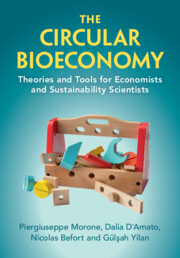Book contents
- The Circular Bioeconomy
- The Circular Bioeconomy
- Copyright page
- Contents
- Figures
- Tables
- Preface
- Acknowledgements
- Note on the Text
- Abbreviations and Notations
- Part I
- Part II
- Part III
- 7 LCA, LCC, and S-LCA Applied to the Bioeconomy
- 8 Innovation Systems and Global Value Chains in the Bioeconomy
- 9 Monitoring Progress towards a Sustainable and Just Bioeconomy
- Index
- References
8 - Innovation Systems and Global Value Chains in the Bioeconomy
from Part III
Published online by Cambridge University Press: 26 October 2023
- The Circular Bioeconomy
- The Circular Bioeconomy
- Copyright page
- Contents
- Figures
- Tables
- Preface
- Acknowledgements
- Note on the Text
- Abbreviations and Notations
- Part I
- Part II
- Part III
- 7 LCA, LCC, and S-LCA Applied to the Bioeconomy
- 8 Innovation Systems and Global Value Chains in the Bioeconomy
- 9 Monitoring Progress towards a Sustainable and Just Bioeconomy
- Index
- References
Summary
The objective of this chapter is to present two approaches useful in the study of the formation and dynamics of particular systems in the bioeconomy. Innovation systems have a horizontal perspective to production processes, while value-chains analysis adopts a vertical perspective. The innovation system approach conceptualises the circulation of knowledge within systems and the way in which the institutional environment favours the development of innovation. The value chain approach is interested in the co-creation of value, its circulation in the international division of labour, and the relations between regions in the world.
Keywords
- Type
- Chapter
- Information
- The Circular BioeconomyTheories and Tools for Economists and Sustainability Scientists, pp. 150 - 165Publisher: Cambridge University PressPrint publication year: 2023



